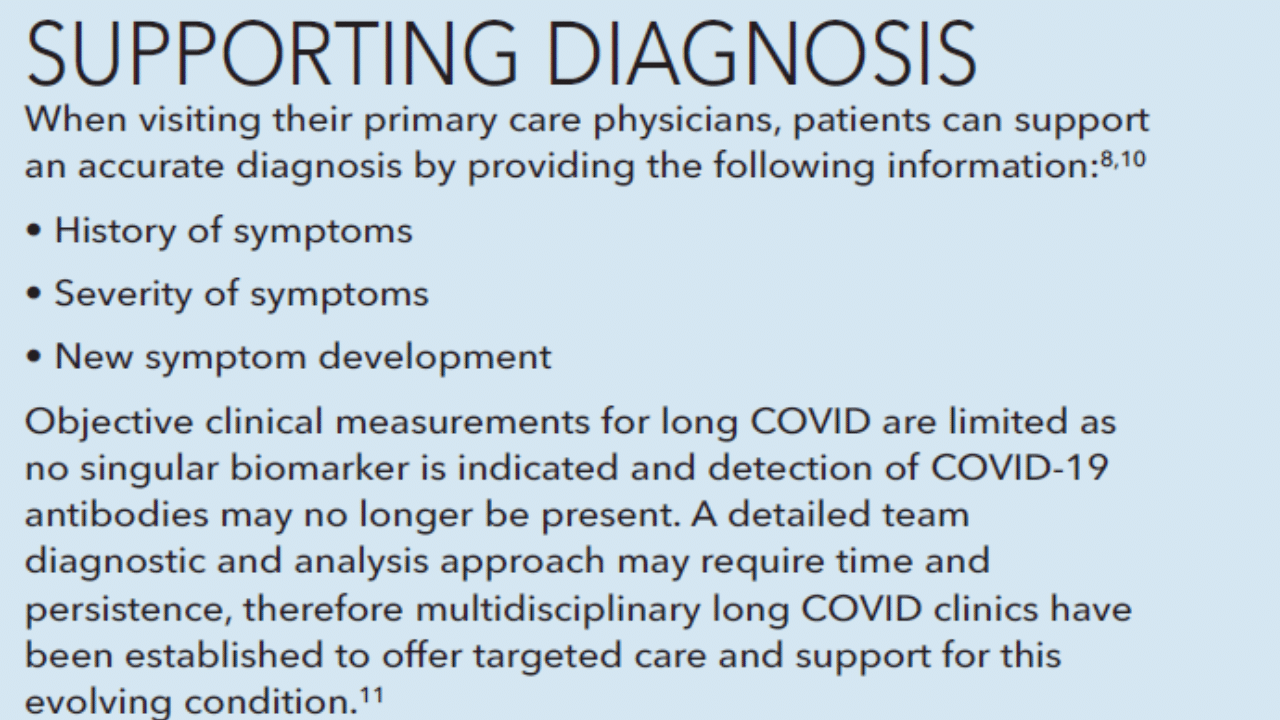
Exploring the Impacts of Long COVID
An emerging epidemic, long COVID may cause enduring and serious side effects.
This course was published in the April 2023 issue and expires April 2026. The authors have no commercial conflicts of interest to disclose. This 2 credit hour self-study activity is electronically mediated.
AGD Subject Code: 010
EDUCATIONAL OBJECTIVES
After reading this course, the participant should be able to:
- Define long COVID and its signs and symptoms.
- Discuss treatments for long COVID.
- Identify long COVID’s implications for oral health and the provision of dental care.
COVID-19 infection, caused by SARS-CoV-2, was initially identified as an acute rather than chronic condition. Early in the pandemic, the medical community recognized that some patients experienced new or lingering symptoms long after their initial infection.1,2 While COVID-19 remains a concern, the rise of chronic symptoms following the resolution of acute illness is a source of academic and research interest.1
Post-acute sequelae of SARS-COV-2 infection (PASC), commonly known as long COVID, is an emerging epidemic with worldwide implications.2–4 Therefore, the National Institutes of Health expects to fund PASC research in excess of $1 billion over the next 4 years.5
In October 2021, the World Health Organization defined long COVID for adults as “a condition impacting daily life with persistent or fluctuating symptoms for at least 2 months following a SARS-CoV-2 infection without an alternative diagnosis.”6 Long COVID is a chronic syndrome that presents with physical and neurological symptoms such as shortness of breath, cognitive issues, and fatigue.7–9
Typically, these patients no longer test positive for COVID-19, but experience continuous, relapsing, or remitting COVID-19 symptoms, or new symptoms that cause reduced physical performance compared to pre-COVID.8,10,11 The severity of acute COVID-19 symptoms does not seem to correlate with the development of long COVID.1,8
While post-viral infection symptoms are common, symptoms occur more frequently post-COVID-19 than with other viruses.7 An estimated 31% to 69% experience post-acute COVID symptoms at 4 weeks after initial illness and recovery.12,13 An estimated 10% continue to experience symptoms for 2 months or more following the initial 12 weeks of acute COVID-19; this is considered long COVID.7
Long COVID has developed with all levels of viral infection severity including without a COVID-19 diagnosis and in those without previous health conditions.4,14–16 Up to 13% are children, with adolescents affected more frequently than younger children.14,17 Unlike adults, children often see symptom improvement or resolution within months.17
Patients with long COVID report multifaceted symptoms, demonstrating the impact on and dysfunction of various organs systems.14,18 Two distinct types of long COVID are theorized: one involving organ damage and the other with consistent chronic pain, fatigue, and brain fog. The two types, however, are not mutually exclusive.19
Causes and Risk Factors
The cause of long COVID is multifactorial and often varies among individuals.10 A likely cause is an exaggerated and prolonged immune response to COVID-19 infection, resulting in chronic inflammation and inflammatory markers common in other immune-related conditions.2,10,14
Another contributing factor is hypercoagulation or thrombosis with COVID-19.20 Long COVID symptoms can demonstrate direct multi-organ damage, varying rates of organ recovery, or an exacerbation of previously undiagnosed conditions.10,14 In addition, depression, anxiety, and difficulty sleeping caused by the social, psychological, and financial stress of the pandemic cannot be excluded as contributing factors.17
Despite the variability of studies, those with poor health or disadvantaged sociodemographic markers are impacted more frequently.3 Prominent determinants include female gender, racial minority groups, advanced age, and preexisting conditions such as smoking, asthma, mental health issues, cardiovascular disease, and obesity.3,4,14,21,22
Women are less likely to develop COVID-19 due to the anti-inflammatory properties of estrogens; however, they are more than twice as likely to experience long COVID.10,22 Middle-aged women are the most affected cohort, but this disparity declines after age 60 when gender risk levels equalize.22
Inflammation associated with obesity increases the risk of prolonged immune response, decreases the threshold for exertion, and increases the likelihood of long COVID.3
Experiencing five or more symptoms in the first week of acute COVID-19 significantly increases the risk of long COVID, regardless of age or gender.23 For those who were hospitalized, pronounced long COVID symptoms are more prevalent; factors can include psychological or financial stress, post-intensive care syndrome, or iatrogenic effects.10

Signs and Symptoms
Symptoms are categorized as cardiopulmonary, neurological/mental health, and post-COVID fatigue syndrome, which can include pain and weakness.10,15
Respiratory. As with acute COVID-19, pulmonary issues, such as hypoxia, fibrotic tissue, and chronic damage, are possible.20,21 Dyspnea, or shortness of breath, is one of the most common symptoms of long COVID with or without a previous diagnosis of pneumonia.8,14 For those who experienced COVID pneumonia, malaise and fatigue were more commonly reported post-recovery by those with higher body mass index scores.8
Fatigue. Profound fatigue is the most reported symptom, especially among women or those with depression and anxiety. Fatigue does not correlate with acute COVID-19 intensity or inflammatory markers; contributions include chronic inflammatory and oxidative stress.10 Long COVID symptoms often overlap with general depression, anxiety, and myalgic encephalomyelitis/chronic fatigue syndrome (ME/CFS).8,11 Fatigue lasting more than 4 months may warrant a co-diagnosis of ME/CFS.8,10
Neurological. Cognitive impacts of long COVID commonly known as brain fog include disorientation, fatigue, difficulty concentrating, and impaired memory. Cognitive issues also encompass sleep disorders, anxiety, low mood and depression, or post-traumatic stress disorder.8,18,24
Anxiety is the most often reported mental health issue with long COVID, followed by depression.21 Both are reported more frequently among the nonhospitalized and often increase in prevalence as symptoms persist.9,13 Additional neurological impacts may encompass moderate to severe tension or migraine-like headaches; neuropathy; muscle pain; changes in balance, taste, and smell alterations; and increased risk of seizures. Severe neurological issues may include weakness, paresthesia and even paralysis.2,14
Cardiovascular. Arrhythmia, chest pain, clotting, myocardial inflammation, right ventricular dysfunction, postural orthostatic hypotension, and postural orthostatic tachycardia syndrome (PoTS) may accompany long COVID.3,10,14 Remaining hospitalized with COVID-19 increases the risk of cardiovascular events. Post-COVID-19 patients can exhibit increased heart rate and arrhythmias, indicative of myocardial inflammation.3 Chest pain is the most commonly reported cardiovascular symptom, followed by palpitations, which can be indicative of arrhythmia.15,20

Section Two
Treatment
Considering the variability of long COVID symptoms, no specific treatment regimen is endorsed. Patients may benefit from receiving multidisciplinary care, symptom monitoring, and physical, mental, and social support. Nonpharmaceutical approaches to shortness of breath include body rotation and stretching, acupuncture, pulmonary rehabilitation, breathing exercises, and singing therapy. Exercise therapy in long COVID rehabilitation is showing promise in increasing strength and cognition.3 Rehabilitation with pulmonary specialists, occupational therapists, physical therapists, and psychologists may improve breathlessness, fatigue symptoms, and quality of life.11 Over-the-counter (OTC) medications may reduce mild pain symptoms.
Treatment for long-COVID may mirror the recommendations for ME/CFS, including symptom management, psychological care, and employment support.3,8,14 Reducing chronic systemic inflammation through weight loss, limiting sugars, graded exercise therapy, and quality sleep can help reduce symptoms.3 Plant-based supplements with concentrated antioxidants from herbs, vegetables, and flavonoids may reduce neuroinflammation and brain fog.4 Prescription-strength analgesics, tricyclic antidepressants, and glucocorticoids also address resistant pain.2
With cardiovascular issues, compression clothing/hose and supportive medications can regulate blood pressure and arrhythmia.3 For PoTS, increasing fluid intake, adding 1 teaspoon to 2 teaspoons of salt, and avoiding dehydrating products, such as caffeine and alcohol, are beneficial.
Vaccination is also a long COVID treatment approach, but with mixed results; some symptoms were reduced while others worsened.3
Impact on Oral Health and Modifications in the Dental Office
Oral health effects depend on long COVID symptoms and severity. Oral lesions include ulcerations or blisters, erythema multiforme-like lesions, candidiasis, leukoplakia and/or erythroplakia, ulcerative or desquamative gingivitis, and secondary viral infections. If patients are taking steroids or other immunosuppressive medications, secondary or opportunistic fungal infections may occur.25,26 Immunosuppressive medications may increase the risk of systemic and oral infections, so oral health professionals need to be diligent in detecting changes and referring to the physician or appropriate dental specialist for follow up care.14
Myalgia within the neck and orofacial muscles can induce myofacial pain, headache, and temporomandibular disorders (TMD).14,25 Noninvasive approaches to TMD include oral appliances, physical and exercise therapy, thermal therapy, acupuncture, and massage. Pharmaceutical approaches encompass pain relievers, anti-inflammatories, muscle relaxers, anti-anxiety and antidepressants medications.27
Persistent or severe symptoms may require additional evaluation and referral to TMD specialists for intra-articular injections or surgical treatment.27 Impaired sense of smell and taste or oral ulcerations may alter nutritional intake or decrease appetite, thereby affecting oral and systemic health. Recommending nutritional counseling may be necessary.16
For xerostomia, treatment options include adequate hydration, increasing humidity in the patient’s residence, use of sugar-free gum/candies, and OTC saliva substitutes containing xylitol.28 Treatment options for specific oral lesions may include: hyaluronic acid gel and chlorhexidine 2% for ulcerative/erosive lesions, and miconazole nitrate for candidiasis. Any oral lesion that does not respond to initial therapy and has not healed in 14 days should be considered for biopsy.25
Severe fatigue and mental health issues can detrimentally impact cognition, motivation to maintain oral hygiene and balanced nutritional intake, and quality of life. Providers must be patient and empathetic in setting realistic expectations, making recommendations, and treatment planning. If symptoms impact the ability of the patient to work, financing dental care may be impacted.14
Pain or fatigue may impact the type of procedure or length of dental appointment that can be tolerated.14 Memory and attentiveness are most frequently affected in those with cognitive issues, so consider having treatment plans and recommendations in writing to take home to review.16
Another potential concern is the inability to provide consent for treatment due to brain fog or the influence of prescription pain medication. Depending on the level of cognitive impact, financial and treatment decisions may be delegated to designated individuals.14
Oral health professionals must anticipate patient concerns about navigating a dental appointment. Decreases in balance and gait, shortness of breath, postural orthostatic tachycardia, chronic pain, and weakness can affect mobility and patient positioning.14
Once safely in the chair, oral health professionals should consider positioning accommodations and shorter appointments. Avoiding the supine position and allowing time to adjust from a reclined position before standing may be necessary.29 For those with a susceptibility to headaches, reducing noise and light stimulation through tinted glasses and ear plugs may be beneficial.
Anesthetic and medication choices may be limited if the patient is experiencing liver, kidney or cardiovascular problems. Anticoagulation treatment must be investigated to accurately assess the potential for increased or prolonged bleeding during and after dental and dental hygiene procedures. Stress involved in a dental appointment could also aggravate underlying cardiovascular issues, resulting in a medical emergency. Consider consulting a patient’s physician prior to invasive or extensive dental procedures.14
Conclusion
As COVID-19 variants continue impacting the world, the prevalence of long COVID is expected to increase. A multidisciplinary approach is needed to determine which diagnostics tests and existing medications may be effective in treating this multifactorial condition.
References
- Wong TL, Weitzer DJ. Long COVID and myalgic encephalomyelit/s/chronic fatigue syndrome (ME/CFS)—a systemic review and comparison of clinical presentation and symptomatology. Medicina. 2021;57:418.
- Tana C, Bentivegna E, Cho SJ,. et al. Long COVID headache. J Headache Pain. 2022;23:93.
- Raman B, Bluemke DA, Lüscher, TF, Neubauer S. Long COVID: post-acute sequelae of COVID-19 with a cardiovascular focus. Eur Heart J. 2022;43:1157–1172.
- Theoharides TC. Could SARS-CoV-2 spike protein be responsible for long-COVID syndrome? Mol Neurobiol. 2022;59:1850–1861.
- Vehar S, Boushra M, Ntiamoah P, Biehl M. Post-acute sequelae of SARS-CoV-2 infection: caring for the ‘long-haulers.’ CCJM. 2021;88:267–272.
- World Health Organization. A Clinical Case Definition of Post COVID-19 Condition by a Delphi Consensus, 6 October 2021. Available at: who.int/publications/i/item/WHO-2019-nCoV-Po_t_COVID-19_condition-Clinical_case_definition-2021.1. Accessed March 7, 2023.
- Subramanian A, Nirantharakumar K, Hughes S, et al. Symptoms and risk factors for long COVID in non-hospitalized adults. Nat Med. 2022;28:1706–1714.
- Sykes DL, Holdsworth L, Jawad N, et al. Post-COVID-19 symptom burden: what is long-COVID and how should we manage it? Lung. 2021;199:113–119.
- Premraj L, Kannapadi NV, Briggs J, et al. Mid and long-term neurological and neuropsychiatric manifestations of post-COVID-19 syndrome: a meta-analysis. J Neurol Sci. 2022;434:120162.
- Raveendran AV, Jayadevan R, Sashidharan S. Long COVID: an overview. Diabetes Metab Syndr. 2021;15:869–875.
- Daines L, Zheng B, Pfeffer P, Hurst JR, Sheikh A. A clinical review of long-COVID with a focus on the respiratory system. Curr Opin Pulm Med. 2022;28;174–179.
- Koc HC, Xiao J, Liu W, Li Y, Chen G. Long COVID and its management. Int J Biol Sci. 2022;18:4768–4780.
- van Kessel SAM, Olde Hartman TC, Lucassen PLBJ, van Jaarsveld CHM. Post-acute and long-COVID-19 symptoms in patients with mild diseases: a systematic review. Fam Pract. 2022;39:159–167.
- France K, Glick M. Long COVID and oral health care considerations. J Am Dent Assoc. 2022;153:167–174.
- Satterfield BA, Bhatt DL, Gersh BJ. Cardiac involvement in the long-term implications of COVID-19. Nat Rev Cardiol. 2022;19:332–341.
- Bungenberg J, Humkamp K, Hohenfeld C, et al. Long COVID‐19: objectifying most self‐reported neurological symptoms. Ann Clin Transl Neurol. 2022;9:141–154.
- Borch L, Holm M, Knudsen M, Ellermann-Eriksen S, Hagstroem S. Long COVID symptoms and duration in SARS-CoV-2 positive children—a nationwide cohort study. Eur J Pediatr. 2022;181:1597–1607.
- Jennings G, Monaghan A, Xue F, Mockler D, Romero-Ortuño R. Comprehensive clinical characterisation of brain fog in adults reporting long COVID symptoms. J Clin Med. 2022;11:3440.
- Horwitz RI, Conroy AH, Cullen MR, et al. Long COVID and medicine’s two cultures. Am J Med. 2022;135:945–949.
- Desai AD, Lavelle M, Boursiquot BC, Wan EY. Long-term complications of COVID-19. Am J Physiol Cell Physiol. 2022;322:C1–C11.
- Bai F, Tomasoni D, Falcinella C, et al. Female gender is associated with long COVID syndrome: a prospective cohort study. Clin Microbiol Infect. 2022;28:611.e9-611.e16.
- Bucciarelli V, Nasi M, Bianco F, et al. Depression pandemic and cardiovascular risk in the COVID-19 era and long COVID syndrome: gender makes a difference. Trends Cardiovasc Med. 2022;32:12–17.
- Aiyegbusi OL, Hughes SE, Turner G, et al. Symptoms, complications and management of long COVID: a review. J R Soc Med. 2021;114:428–442.
- Stefano GB. Historical insight into infections and disorders associated with neurological and psychiatric sequelae similar to long COVID. Med Sci Monit. 2021;27:e931447.
- Chakraborty T, Jamal RF, Battineni G, Teja KV, Marto CM, Spagnuolo G. A review of prolonged post-COVID-19 symptoms and their implications on dental management. Int J Environ Res Public Health. 2021;18:5131.
- Farid H, Khan M, Jamal S, Ghafoor R. Oral manifestations of Covid‐19‐a literature review. Rev Med Virol. 2022;32:e2248.
- Liu F, Steinkeler A. Epidemiology, diagnosis, and treatment of temporomandibular disorders. Dent Clin North Am. 2013;57:465–479.
- Villa A, Connell, C, Abati S. Diagnosis and management of xerostomia and hyposalivation. Ther Clin Risk Manag. 2014;11:45–51.
- Dani M, Dirksen A, Taraborrelli P, et al. Autonomic dysfunction in ‘long COVID’: rationale, physiology and management strategies. Clin Med (Lond). 2021;21:e63–e67.
From Dimensions of Dental Hygiene. April 2023; 21(4):36,39-41.



